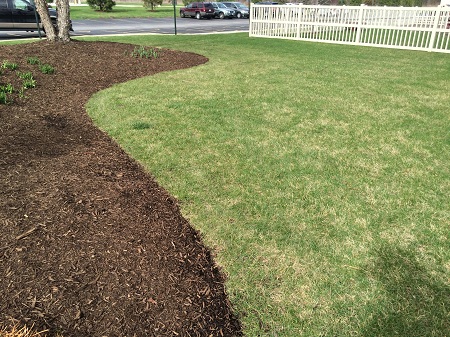
Other Services
Vacant Lot & Field Mowing
Whether you are a builder with large overgrown vacant lots, or a municipality with abandoned homes that need mowing, Suburban Landscaping can help. Our vacant lot mowing and field mowing services are available all season long to all areas of Chicago and Northwest Indiana.
Services Offered
Professional equipment and knowledge is just the beginning of the services we can provide for owners or managers of large vacant lots.
- Rough Cut Mowing
- Finish Grass Mowing
- Trash Pick Up
- Debris Removal
- Grading
- Seeding
- Chemical Control
Some of the types of mowing we can offer: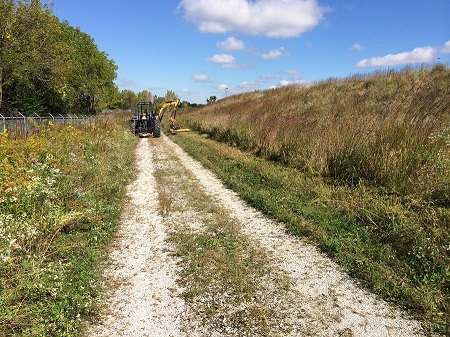
- University & School Athletic Fields
- Amphitheaters
- Home Owner Association Vacant Lots
- Commercial Broker Vacant Lots
- Retention Ponds
- Easements
- Developers & Unsold Property
- Native Grass Remediation
- Prairie Mowing
- Road Easements & Ditches
- Airport Mowing
- Water & Sanitary Districts
- Municipality Vacant Lots
- State Mowing
- Pipeline Right-Of-Ways
- Railroad Mowing
Reduced Risks
Vacant lots or fields can be a significant liability for the owners of the property. Injury lawsuits, grass fires, and municipal violations are just a few of the issues that face vacant lot owners. Other potential problems often associated with vacant lots are rodent infestation, mosquito habitats, and snake lairs. Vacant lots with tall grass offer great hiding places and often attract illegal dumping and playing children. Reduce your risks and call us to mow your large vacant lot.
Field mowing has many benefits such as: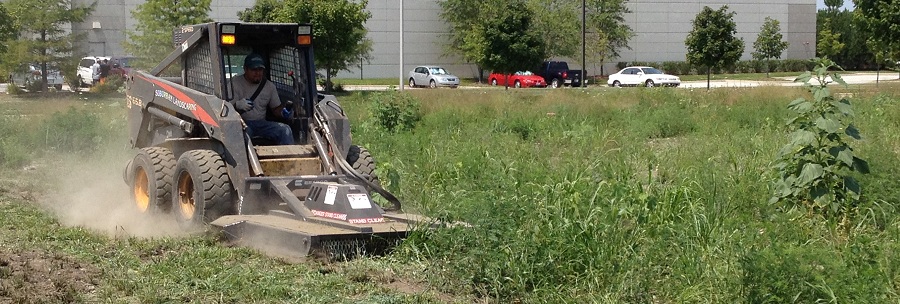
- Compliance with local regulations
- Reduces fire hazards
- Reduces weeds
- Prepares properties for planting or building
- Make your property more sellable
- Better relations with the neighboring properties
- Reduces illegal dumping possibilities
- Reduces varmint infestations
Vacant Lot Mowing Contracts Available
Our vacant lot mowing service is available to any large vacant lot owner in our service area. We can provide our trained operators and equipment on a per-call basis or on a seasonal monthly contract. We can schedule bi-weekly, monthly or bi-monthly service depending upon your needs and local codes.
What Does Vacant Lot Or Field Mowing Cost?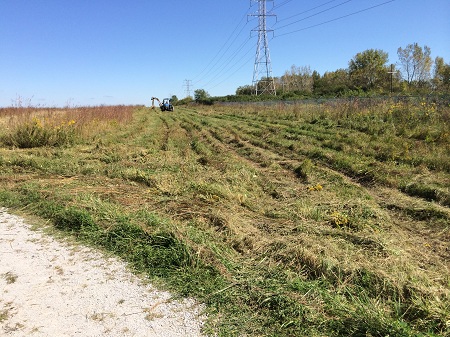
Our vacant lot mowing service equipment is designed for the larger fields and vacant lots, usually more than one acre. Each property for our vacant lot mowing service is estimated and priced depending upon the service needed and the location. Every field is different, including the type of mowing, vegetation height, and equipment required. However, we do have a minimum visit for one-time vacant lot mowing service of $600. Monthly mowing contracts are also available at a much lower rate. The best way to know your cost on this wide ranging service is to call our office or request a quote online.
Scheduling Vacant Lot Mowing
To schedule a one-time or repeat visit service, please contact our closest location for a free estimate. Please note that due to our existing clients, one-time service visits usually require a 5-10 days advanced notice.
Insurance
Another advantage for clients who use our vacant lot mowing service is that they are fully protected by all of our insurances. Everything including our men, our equipment, and your neighbors property are covered by our insurance policies. To see our insurance page click this link.
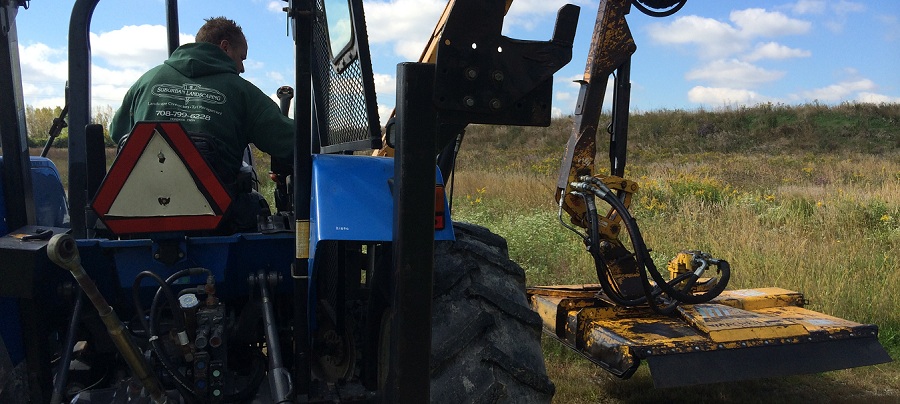
Installing Mulch
Mulching of the planting beds is a very important item from a horticultural aspect that is often overlooked. Mulching the beds offers many health benefits to the existing landscape, as well as improve the aesthetics of your property.
Benefits Of Mulch
- Mulch breaks down with time into nutrients that the plants need, flowing into the soil and feeding the plants through their root systems. Think of mulch as a 3” layer of solid plant food.
- Prevents loss of water from the soil by evaporation.
- Reduces the growth of weeds, when applied deeply enough to prevent weed germination or to smother existing weeds.
- Keeps the soil cooler in the summer and warmer in the winter, thus maintaining a more even soil temperature and promoting better root development resulting in improved growth and blooms.
Installing Mulch
Mulching of the planting beds is a very important item from a horticultural aspect that is often overlooked. Mulching the beds offers many health benefits to the existing landscape, as well as improve the aesthetics of your property.
Benefits Of Mulch
- Mulch breaks down with time into nutrients that the plants need, flowing into the soil and feeding the plants through their root systems. Think of mulch as a 3” layer of solid plant food.
- Prevents loss of water from the soil by evaporation.
- Reduces the growth of weeds, when applied deeply enough to prevent weed germination or to smother existing weeds.
- Keeps the soil cooler in the summer and warmer in the winter, thus maintaining a more even soil temperature and promoting better root development resulting in improved growth and blooms.
- Prevents soil splashing, which not only stops erosion but keeps soil-borne diseases from splashing up onto the plants.
- Mulches can improve the soil structure. As the mulch decays, the material becomes topsoil. Decaying mulch also adds nutrients to the soil.
- Prevents crusting of the soil surface, thus improving the absorption and movement of water into the soil.
- Prevents the trunks of trees and shrubs from damage by lawn equipment.
- Helps prevent soil compaction.
- Plants have more roots than plants that are not mulched, because mulched plants will produce additional roots in the mulch that surrounds them.
- Mulch also allows for weeds to be pulled while their roots are growing in the mulch, instead of roots growing into the soil where they could break off and re-grow again.
Even if your beds have don’t have plants, mulch will still benefit you by breaking down into nutrient form and enriching your existing soil. A test in the town of Crete, Illinois showed that in one year, 3” of hardwood mulch turned 1” of clay soil into usable, nutrient rich soil.
There is one draw back to hardwood mulch. It needs to be top-dressed every couple of years, depending upon how much mulch is installed. Our general recommendation is to install and maintain a level of approximately 3”-4” of mulch at all times, which should give you enough coverage for two seasons. However, for budget purposes, we can install 2” of mulch in all beds which would provide a good start, but might not last as long.
Colored Mulches
Most colored mulches are a man-made invention, dying the natural mulch to a black, red, or other color. Some mulches such as cypress mulch are naturally lighter and offer a different appearance. Although attractive when first installed, colored mulches can loose their color over time by fading in the sun or being exposed to large amounts of water. Top dressing of colored mulches can often be required more frequently than natural mulches.
When To Mulch
Any time is a good time to mulch your beds, even though there are different benefits at different times of year, mulching is a wonderful assistance to plants and soil all year round.
Winter mulching is primarily used as insulation for woody plants, laid down in late fall to keep the soil evenly cool throughout the winter. Winter mulching still provides all of the benefits of mulch listed above.
Spring/Summer mulching is normally after the soil begins to warm in the spring. The primary roles of summer mulches are to warm the soil, reduce weed growth, and retain soil moisture. Spring/Summer mulching still provides all of the benefits of mulch listed above.
How Deep to Mulch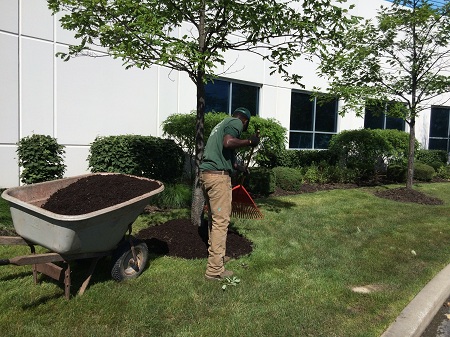
Proper installation of mulch is more important than most clients realize. The amount of mulch to apply depends on the texture and density of the mulch material. Many wood and bark mulches are composed of fine particles and should not be more than 3 - 4 inches deep. Excessive amounts of these fine-textured mulches can suffocate plant roots, resulting in yellowing of the leaves and poor growth. Heavier, coarse-textured mulches such as pine bark nuggets allow good air movement through them and can be as deep as 4 inches. Mulches composed of grass clippings or shredded leaves should never be deeper than 2 inches, because these materials tend to mat together, restricting the water and air supply to plant roots. Mulch piled too high on the crown of a tree can also cause problems, trapping excessive moisture on the trees' bark can cause disease and rotting of the tree trunk.
How to Calculate the Amount of Mulch Needed
Suburban Landscaping installs mulch by the universal measurement of cubic yards, which is 27 cubic feet. To determine how much mulch you need, measure your areas length and width, multiply the length by the width, and that is your square footage. The square footage of a circular bed is the distance from the middle of the circle to the outside, multiplied by itself and then multiplied by 3.14.
- One cubic yard will cover 90 square feet with 3" of mulch (recommended)
- One cubic yard will cover 160 square feet with 2" of mulch
- One cubic yard will cover 320 square feet with 1" of mulch
Installing Weed Barrier Under Mulch
Mulch in itself is a weed barrier, but you can install a weed barrier under shredded mulch if you like. A fabric or plastic weed barrier will not effect most of the beneficial properties of mulching. Click this link to read more about the difference between landscape fabrics and black plastics.
Possible Problems When Mulching
Artillery Fungus
Occasionally, the naturally occurring micro-organisms in cellulose mulches can become a nuisance. The shotgun or artillery fungus (Sphaerobolus) may cause serious problems. While it decays the mulch, it also produces fruiting structures that resemble tiny cream or orange-brown cups that hold a spore mass resembling a tiny black egg (1/10 inch in diameter). This fungus shoots these spore masses high into the air. They stick to any surface and resemble small tar spots on leaves of plants, on cars or on the siding of homes. To avoid damage, Suburban Landscaping does not use mulches that contain cellulose (wood), we use pure bark mulches.
Slime Mold
Slime mold is another type of nuisance fungus that appear as an unsightly bright yellow or orange slimy masses that may be several inches to a foot or more in diameter. They are harmless but unsightly, with some fungi producing toad stools (mushrooms).
Although highly unlikely to occur, these fungi can arise every once in a great while. Fortunately, we buy our mulches in such large quantities that if a fungus is present, we will see it in our stock pile and eradicate it long before a customer ever would have noticed it.
What Does Mulching Cost?
There are a few variables that determine the price of mulching such as amount of mulch, location, and time of year. We would be happy to provide you with a free consultation and estimate, or visit our pricing guide for some approximate prices. Mulch installation is always charged by the cubic yard installed, with prices ranging from $75 per cubic yard installed to as low as $42 Per cubic yard installed.
© Suburban Landscaping 2015
Lawn Aerating
Annual lawn aeration is the secret to making your lawn healthy, lush and green. You could simply aerate a lawn area and after a few weeks without having applied fertilizers at all, notice a dramatic increase in color, growth pattern and density.
Water and air are very important to the soil ecosystem, and to the health of the soils micro-organisms that naturally break down thatch in healthy lawns. Good drainage conditions and ensuring an adequate amount of air in the topsoil are essential so grass roots can breathe and grow. When air reaches the coil level, a gaseous exchange can take place: the grass roots take in oxygen and release carbon dioxide. Accumulations of carbon dioxide in the soil can restrict root development and limit the intake of water and nutrients.
What Is Lawn Aeration?
Aerating your lawn is one of the best horticultural services you can have done to your lawn. Aeration is the mechanical removal of small 2” plugs of your lawn, thatch layer, and soil. When the plug of soil and lawn are removed, they leave many small holes in your lawn about the size of your finger. These holes allow air, water, and fertilizer directly into the root zone, and also allow new grass to develop in these holes. The plugs, or “cores” are left on top of the lawn and naturally break down and reincorporate back into the soil. Aeration is done routinely on golf courses and sports fields, and is the main reason for their thick, healthy lawns.
Benefits Of Aeration
Aerating your lawn provides many horticultural benefits to your turf. The main benefit is allowing air, water, and fertilizer directly to the root system of the lawn, by way of the holes that aerating creates.
The plugs that are removed from the lawn are also a beneficial part of aerating. The plugs themselves contain harmless bacteria and microorganisms, that helps breakdown organic matter like thatch and dead grass blades.
By aerating your lawn you provide the following benefits to your lawn and its root system:
- Thickens the lawn
- Allows new grass blades to develop
- Reduces soil compaction, allowing roots to grow
- Improves drainage and reduces standing water problems
- Allows water, air, and fertilizer into the root zone.
- Reduces thatch build up
- Allows new seeds to have direct soil contact to increase rooting depth
- Improves nutrient uptake
- Improves gaseous exchange between the soil and atmosphere
- Stimulates the soil borne microbes and their activity
- Strengthens and deepens the root system
- Absorbs rain water better
- Reduced heat/drought stress (if done before the drought)
- Disrupts soil layering
How Do I Know If I Need To Aerate?
There are a few easy ways to know if you need to aerate your lawn. First is a simple test, just dig a small section out of your lawn about 6” deep, and if the root system is less than 3” you may need to aerate your lawn. The second would be if you have any one of these conditions:
- If you have clay soil
- If your lawn is heavily used
- If your lawn is driven on
- If you have a thatch lawyer more than ½”
When Is The Best Time Of Year To Aerate?
For lawns in Illinois and Indiana, which are primarily a blend of Kentucky Bluegrass and perennial Ryegrass, aeration should only be done in Spring or Fall, but exact timing depends upon the year and climate conditions. For the best results when aerating, the soil needs to be somewhat moist, but not saturated. Trying to aerate dry soil is like trying to poke a hole in concrete, it doesn’t work. The moist soil allows for the tines of the machine to penetrate into the soil and remove a deeper plug, which increases the benefit of the aeration service. No mater your lawn type or soil type, we recommend avoiding aeration in the hot summer months of June and July.
How Often Should I Aerate?
Aeration should be done at least once a year on most lawns, with two aerations being optimal. A good practice for the health of your lawn would be to aerate every spring and fall. There are other horticultural factors that may require you to aerate more often, such as a thatch or drainage issue.
How Does Aeration Relieve Compaction?
Lawn compaction can be one of the worst enemies to a healthy lawn. Compaction can be caused in any lawn from everyday things like riding lawn mowers, lots of foot traffic, and kid’s playing, or from the unusual such as construction equipment or parking a car on the lawn. If your lawn is very wet or very dry when these things occur, the compaction can be much greater. Compacting a lawn presses the soil particles together, greatly reducing the size of the pore space within the soil that normally contains air and water. The root system of your lawn requires oxygen to absorb water and nutrients, both essential to root growth. A compacted lawn will not get the vital oxygen it needs and the top blades of the lawn will start to decline. Aeration will open up new pores in the soil and allow large amounts of oxygen into the soil again, thus, energizing the process of new grass development.
Do I Need To Aerate If I De-Thatched?
In short, yes. Aeration and de-thatching are two different services providing two different sets of benefits. While aeration does remove some thatch, de-thatching does not provide any of the benefits of aeration. Aeration is highly recommended every year, whereas de-thatching, or “power-raking” should only be done when there is an excess of thatch.
Are There Different Kinds Of Aerating?
Yes. In most professional equipment the times are hollow or spoon-shaped, allowing for the removal of a plug of soil, thatch, and grass. Other types of aeration include spiking and slicing, neither of which remove a plug of soil. Spiking of the lawn, which uses a solid spike instead of a hollow tine, can actually increase compaction around the edges of the hole. Additionally, there are vertical and drum type aerators, which also produce different results. Vertical coring aeration results in a cleaner, more effective aeration job.
For this reason, we use the revolutionary "Ryan Lawnaire 28" core aerator. This machine is the top of the line machine and the only brand machine that uses vertical piston driven spoons to remove the cores. Making it by far the most beneficial type of machine available for lawn aeration.
Aerating Tips
- Do not aerate during periods of drought as holes can crack open.
- Watering the lawn the night before aerating can make it easier to aerate a very dense lawn.
- Prior to aerating, it is best to mow the lawn really low, ideally the day before
- Aeration is best carried out when the soil is moist, but not wet.
- Newly seeded or sodded lawns do not need aeration
- Fertilizer or grass seed can be applied directly after aerating
- If you have sprinkler heads, they need to be marked before we aerate
- It is difficult to aerate heavy clay soils or around tree roots
- You cable television cable may be buried to shallow and may get cut
- Soil cores on the lawn with breakdown with 2-3 weeks
What Does Lawn Aeration Cost?
Like many services we offer, the cost depends on the size of your lawn. Aeration for small lawns, such as under 4,000 square feet can be as low as $70. Larger lawns can run a little more, but even some of the biggest residential lawns should be under $200. We often run aeration "specials" or discounts in our advertising. Check the Specials & Discounts" page on our site for aeration deals. For an estimate on aerating your lawn, please call our office or request a quote online.
